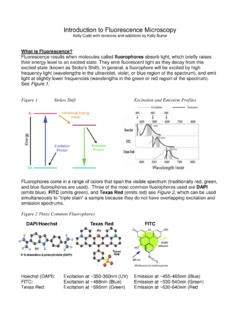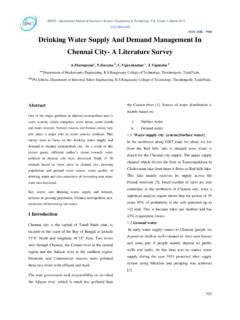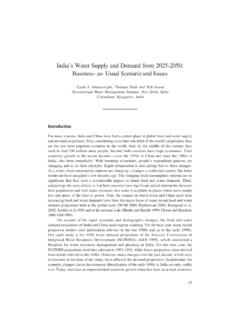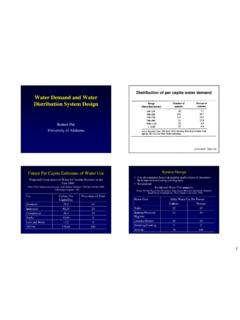Transcription of Water Supply and Demand in California
1 1 | w a t e r s u p p l y By Stephanie Anagnoson College of the Canyons 2018 Version 1 Photo By Jani Brumat Water Supply and Demand in California By Stephanie Anagnoson College of the Canyons 2017 Version 1 Photo by Nathan Roser on Unsplash 2 | w a t e r s u p p l y Attributions Castaic Lake Water Agency College of the Canyons College of the Canyons - Water Systems Technology College of the Canyons - Open Educational Resources This textbook is licensed under CC BY 3 | w a t e r s u p p l y Table of Contents Introduction to Water Supply 4 Part One: Water All Around Us 5 Section Water Cycle 6 Section Water Management Concepts 10 Section Water Rights 16 Section Stakeholder Concepts 20 Part Two: Supply -Side Management 24 Section Los Angeles Aqueduct 26 Section Central Valley Project 29 Section Colorado River Aqueduct 33 Section State Water Project 37 Section Alternative Water Supplies 41 Part Three.
2 Demand -Side Management 49 Section Regulations 50 Section Water Loss 55 Section Water Rates 58 Section Indoor Water Use 61 Section Outdoor Water Use 66 Section CII Water Use 72 Section Social Marketing Campaigns 77 4 | w a t e r s u p p l y Introduction to Water Supply You re about to understand Water Demand and Water Supply more deeply. This understanding is going to change how you look at your Water bill, grass in your yard and around town, and all those canals you see while driving around in California . Understanding the connection between Demand and Supply is critical to anyone working in the Water industry today.
3 Water Demand is our need and use of Water . Water Supply refers to our sources of Water . This textbook has three primary parts. In Part One, you will learn foundational concepts in Water Supply , including the Water cycle, Water management concepts, Water rights and stakeholder concepts. In Part Two, you will apply what you learned in Part One to Water development projects and Supply side management including the Los Angeles Aqueduct, Central Valley Project, Colorado River Aqueduct and State Water Project. There are voluminous books written on each of these projects, so you will not learn everything about each project here, but rather key details that characterize each project s purpose, stakeholders, development, and future.
4 You will also explore alternative Water supplies, including desalination. In Part Three, you will learn about Demand management, which includes using legislation and regulatory tools, Water rates, and conservation programs to manage Water use. Rather than simply understanding Demand management as conservation program-based, you will learn that there are powerful ways, sometimes far more useful at times than conservation programs, to decrease Demand in the long-term. Photo used with permission of Castaic Lake Water Agency Photo used with permission of Castaic Lake Water Agency Photo by the Bureau of Reclamation is in the public domain 5 | w a t e r s u p p l y Part One: Water All Around Us In Part One of this text, we ll explore the basics of Water Supply and Demand .
5 We ll review the Water cycle, explore basic concepts in Water management, introduce surface Water and groundwater rights, and then introduce the ideas of stakeholders in Water projects. Part One is divided into these four sections: The Water Cycle Water Management Concepts Water Rights Stakeholder Concepts For many of you, the Water Cycle will not be a new concept. But now you will need to frame it differently. Rather than considering it as a scientific concept, you'll have to see the interface between science and society and between Supply and Demand .
6 Water management concepts will take the Water cycle further as you learn how different sources of groundwater and surface Water supplies are identified and used both separately and together. There are benefits and drawbacks to each type of source of Water . Water rights are important to all aspects of the Water Supply . While we can't make you an attorney, you'll understand the basic types of Water rights in California by the end of this section. And lastly, in Part One, you'll finish with an examination of stakeholders in different Water issues.
7 Stakeholders aren't just a concept from business theory. They are critical to how we get things done in the Water industry. You'll look at a few real life examples of the consequences of working with (or neglecting) stakeholders in the Water industry. Hydraulic Gold Mining by Carlton Wakins is in the public domain - Hydraulic mining in the 1880s in Nevada City, California 6 | w a t e r s u p p l y Section Water Cycle In this section, we ll dive deeper into the Water cycle in terms of how it affects Water Supply . After reading this section, you should be able to: identify processes in the Water cycle that influence the Water Supply ; analyze situations in terms of precipitation, condensation, evaporation and transpiration; and Evaluate yearly data for evapotranspiration.
8 You've probably heard on the news the statewide Water Supply in California described in terms of snowpack and rainfall. These are critical measures of how much Water is available for human use. Water managers in California follow both snowpack measurements and rainfall measurements closely. In the diagram above from the United States Geological Survey ( ), you can see that precipitation is shown as rainfall and snow. Precipitation also includes something you don t see too often in California : hail and sleet. All forms of Water that fall from the sky, including rain, snow, hail and sleet, are forms of precipitation.
9 Rainfall can provide much needed Water in the ground by the process of infiltration, the process by which Water seeps into the ground and eventually recharges our groundwater, Water stored in the ground. Using the diagram above, you can also trace the flow of groundwater in some cases to both rivers, lakes, and even to the ocean. Above ground, rainfall can also be stored on earth s surface in lakes. Precipitation in California also provides snow for snowpack, which can be our largest area of storage of Water in the winter. In fact, it is common for Water managers to view the snowpack in the Sierra as a The Water Cycle by John Evans and Howard Perlman is in the public domain 7 | w a t e r s u p p l y reservoir; it is simply a seasonal reservoir that melts in the spring.
10 Snowmelt runoff from the snowpack can fill streams and lakes. Runoff from rainfall is also captured in streams and lakes and can serve to recharge aquifers through percolation and infiltration. The diagram also shows the key process of evaporation, or the process through which liquid Water turns into a gas. Evaporation occurs over bodies of Water like the ocean or lakes, but also over the land. If you own a home with a pool, you have probably noticed that if you leave the pool without a cover in the summer, you have to add Water more often in the summer than in the winter.



















